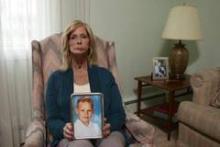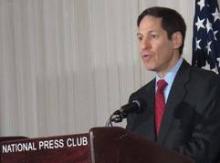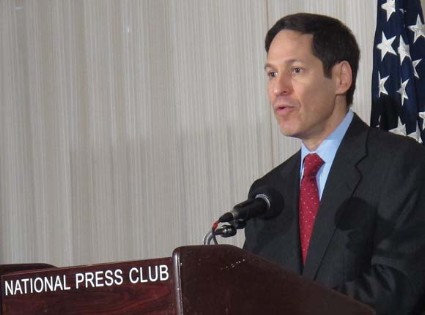User login
Almost 2 million Americans tried to quit smoking in the wake of a 2012 government educational campaign, and at least 100,000 of them have quit permanently.
That’s according to an analysis of the Centers for Disease Control and Prevention’s (CDC’s) Tips From Former Smokers campaign that was published online in the Lancet on Sept. 9 (doi: 10.1016/S0140-6736(13)61686-4). The analysis by CDC officials estimates that 1.6 million Americans tried to quit after the campaign’s launch in March 2012. By June 2012, when it ended, at least 100,000 of them could be defined as having permanently quit.
"These are really minimal estimates," said Dr. Thomas Frieden, director of the CDC, in a briefing with reporters. "We think the actual impact may have been even larger than this."
The Tips From Former Smokers campaign was made possible by a $54 million grant from the Affordable Care Act’s Public Health and Prevention Fund. Print ads featured graphic photos of former smokers with stomas, or scars from open heart surgery. Former smokers also described tobacco’s toll on their health in broadcast and radio ads and videos posted to the CDC website. The TV ads directed viewers to the 1-800-QUIT-NOW quit line or to the National Cancer Institute’s quit assistance website, www.smokefree.gov.
A testimonial from former smoker Terrie Hall has been the most-visited page on the entire CDC site, receiving 2.5 million hits so far, Dr. Frieden said. In it, Ms. Hall tells smokers: "Record your voice for loved ones while you still can." Ms. Hall was diagnosed with throat cancer, had her larynx removed, and now speaks with the aid of an artificial voice box.
Overall, the tips campaign was seen by four out of five smokers, the Lancet report estimated.
To assess how well the campaign worked, the CDC used a nationally representative online survey. Current smokers – those who had smoked at least 100 cigarettes in their lifetime and now smoked every day or some days – and nonsmokers (all others) were compared. There was a baseline survey before the campaign started and another immediately after the campaign ended.
Of the invited smokers, 70% (4,108) responded, and 58% (3,000) of the invited nonsmokers responded to the baseline survey. After the campaign ended, 74% (3,058) of the smokers and 74% (2,220) of the nonsmokers responded. About 75% of the smokers and nonsmokers said they recalled seeing at least one tips ad.
The prevalence of smokers who tried to quit in the past 3 months increased from 31% before the tips campaign to 35% after the campaign. At the end of the 12-week campaign, 13% of smokers who tried to quit said they had not smoked again.
After stratifying the results of the overall response to the campaign, the CDC researchers found that there were more quit attempts among younger smokers, lighter smokers, African American smokers, and smokers with less education.
Calls to the 1-800-QUIT-NOW line increased 132% during the 12-week campaign, 200,000 more calls than during the same period the previous year. There were also 500,000 unique visitors to the www.smokefree.gov website.
The analysis showed that the campaign spurred a large number of nonsmokers to talk to their friends or family about the dangers of smoking and quitting. Applying the findings to the U.S. population, the researchers reported that almost 5 million nonsmokers recommended a smoking cessation service to a friend or family member, and 6 million discussed the dangers of smoking.
Lisha Hancock was one of those smokers who heard from a family member about quitting, but she also said that she was influenced greatly by Terrie Hall’s story. Ms. Hancock told reporters that she smoked for 17 years, starting at age 21. Family and peer pressure did not motivate her to quit. But her 5-year-old son’s questions and response to Ms. Hall’s ads, along with her own impressions from Ms. Hall’s testimonial, moved her. "You can see the regret and sadness in her eyes," said Ms. Hancock, in a conference call.
After seeing the ads and online testimonials, Ms. Hancock decided to make a plan, made some diet and exercise changes, and used nicotine lozenges to help her quit. She has gone about 6 months without smoking, she said.
The CDC report found that thanks to more people quitting, the campaign may have added 500,000 quality-adjusted life-years to the U.S. population, which suggests a cost per life-year saved of less than $200. That ranks the campaign "among the most cost-effective preventive interventions," said the CDC authors.
Meanwhile, the $54 million spent on the campaign is less than what the tobacco industry spends for 3 days of marketing, according to the report. The industry’s $8 billion in annual spending far outweighs the federal government’s capabilities, but Dr. Frieden said he was optimistic. "We’re going to win that David and Goliath battle," he told reporters.
Dr. Frieden said that the study results validated a large, national educational antismoking campaign. The CDC will continue to find ways to alert the public to the dangers of smoking, he said. The agency ran additional Tips From Former Smokers ads between March and June this year. That campaign included exhortations for smokers to talk to their physicians about quitting.
The authors reported having no financial disclosures.
On Twitter @aliciaault
Almost 2 million Americans tried to quit smoking in the wake of a 2012 government educational campaign, and at least 100,000 of them have quit permanently.
That’s according to an analysis of the Centers for Disease Control and Prevention’s (CDC’s) Tips From Former Smokers campaign that was published online in the Lancet on Sept. 9 (doi: 10.1016/S0140-6736(13)61686-4). The analysis by CDC officials estimates that 1.6 million Americans tried to quit after the campaign’s launch in March 2012. By June 2012, when it ended, at least 100,000 of them could be defined as having permanently quit.
"These are really minimal estimates," said Dr. Thomas Frieden, director of the CDC, in a briefing with reporters. "We think the actual impact may have been even larger than this."
The Tips From Former Smokers campaign was made possible by a $54 million grant from the Affordable Care Act’s Public Health and Prevention Fund. Print ads featured graphic photos of former smokers with stomas, or scars from open heart surgery. Former smokers also described tobacco’s toll on their health in broadcast and radio ads and videos posted to the CDC website. The TV ads directed viewers to the 1-800-QUIT-NOW quit line or to the National Cancer Institute’s quit assistance website, www.smokefree.gov.
A testimonial from former smoker Terrie Hall has been the most-visited page on the entire CDC site, receiving 2.5 million hits so far, Dr. Frieden said. In it, Ms. Hall tells smokers: "Record your voice for loved ones while you still can." Ms. Hall was diagnosed with throat cancer, had her larynx removed, and now speaks with the aid of an artificial voice box.
Overall, the tips campaign was seen by four out of five smokers, the Lancet report estimated.
To assess how well the campaign worked, the CDC used a nationally representative online survey. Current smokers – those who had smoked at least 100 cigarettes in their lifetime and now smoked every day or some days – and nonsmokers (all others) were compared. There was a baseline survey before the campaign started and another immediately after the campaign ended.
Of the invited smokers, 70% (4,108) responded, and 58% (3,000) of the invited nonsmokers responded to the baseline survey. After the campaign ended, 74% (3,058) of the smokers and 74% (2,220) of the nonsmokers responded. About 75% of the smokers and nonsmokers said they recalled seeing at least one tips ad.
The prevalence of smokers who tried to quit in the past 3 months increased from 31% before the tips campaign to 35% after the campaign. At the end of the 12-week campaign, 13% of smokers who tried to quit said they had not smoked again.
After stratifying the results of the overall response to the campaign, the CDC researchers found that there were more quit attempts among younger smokers, lighter smokers, African American smokers, and smokers with less education.
Calls to the 1-800-QUIT-NOW line increased 132% during the 12-week campaign, 200,000 more calls than during the same period the previous year. There were also 500,000 unique visitors to the www.smokefree.gov website.
The analysis showed that the campaign spurred a large number of nonsmokers to talk to their friends or family about the dangers of smoking and quitting. Applying the findings to the U.S. population, the researchers reported that almost 5 million nonsmokers recommended a smoking cessation service to a friend or family member, and 6 million discussed the dangers of smoking.
Lisha Hancock was one of those smokers who heard from a family member about quitting, but she also said that she was influenced greatly by Terrie Hall’s story. Ms. Hancock told reporters that she smoked for 17 years, starting at age 21. Family and peer pressure did not motivate her to quit. But her 5-year-old son’s questions and response to Ms. Hall’s ads, along with her own impressions from Ms. Hall’s testimonial, moved her. "You can see the regret and sadness in her eyes," said Ms. Hancock, in a conference call.
After seeing the ads and online testimonials, Ms. Hancock decided to make a plan, made some diet and exercise changes, and used nicotine lozenges to help her quit. She has gone about 6 months without smoking, she said.
The CDC report found that thanks to more people quitting, the campaign may have added 500,000 quality-adjusted life-years to the U.S. population, which suggests a cost per life-year saved of less than $200. That ranks the campaign "among the most cost-effective preventive interventions," said the CDC authors.
Meanwhile, the $54 million spent on the campaign is less than what the tobacco industry spends for 3 days of marketing, according to the report. The industry’s $8 billion in annual spending far outweighs the federal government’s capabilities, but Dr. Frieden said he was optimistic. "We’re going to win that David and Goliath battle," he told reporters.
Dr. Frieden said that the study results validated a large, national educational antismoking campaign. The CDC will continue to find ways to alert the public to the dangers of smoking, he said. The agency ran additional Tips From Former Smokers ads between March and June this year. That campaign included exhortations for smokers to talk to their physicians about quitting.
The authors reported having no financial disclosures.
On Twitter @aliciaault
Almost 2 million Americans tried to quit smoking in the wake of a 2012 government educational campaign, and at least 100,000 of them have quit permanently.
That’s according to an analysis of the Centers for Disease Control and Prevention’s (CDC’s) Tips From Former Smokers campaign that was published online in the Lancet on Sept. 9 (doi: 10.1016/S0140-6736(13)61686-4). The analysis by CDC officials estimates that 1.6 million Americans tried to quit after the campaign’s launch in March 2012. By June 2012, when it ended, at least 100,000 of them could be defined as having permanently quit.
"These are really minimal estimates," said Dr. Thomas Frieden, director of the CDC, in a briefing with reporters. "We think the actual impact may have been even larger than this."
The Tips From Former Smokers campaign was made possible by a $54 million grant from the Affordable Care Act’s Public Health and Prevention Fund. Print ads featured graphic photos of former smokers with stomas, or scars from open heart surgery. Former smokers also described tobacco’s toll on their health in broadcast and radio ads and videos posted to the CDC website. The TV ads directed viewers to the 1-800-QUIT-NOW quit line or to the National Cancer Institute’s quit assistance website, www.smokefree.gov.
A testimonial from former smoker Terrie Hall has been the most-visited page on the entire CDC site, receiving 2.5 million hits so far, Dr. Frieden said. In it, Ms. Hall tells smokers: "Record your voice for loved ones while you still can." Ms. Hall was diagnosed with throat cancer, had her larynx removed, and now speaks with the aid of an artificial voice box.
Overall, the tips campaign was seen by four out of five smokers, the Lancet report estimated.
To assess how well the campaign worked, the CDC used a nationally representative online survey. Current smokers – those who had smoked at least 100 cigarettes in their lifetime and now smoked every day or some days – and nonsmokers (all others) were compared. There was a baseline survey before the campaign started and another immediately after the campaign ended.
Of the invited smokers, 70% (4,108) responded, and 58% (3,000) of the invited nonsmokers responded to the baseline survey. After the campaign ended, 74% (3,058) of the smokers and 74% (2,220) of the nonsmokers responded. About 75% of the smokers and nonsmokers said they recalled seeing at least one tips ad.
The prevalence of smokers who tried to quit in the past 3 months increased from 31% before the tips campaign to 35% after the campaign. At the end of the 12-week campaign, 13% of smokers who tried to quit said they had not smoked again.
After stratifying the results of the overall response to the campaign, the CDC researchers found that there were more quit attempts among younger smokers, lighter smokers, African American smokers, and smokers with less education.
Calls to the 1-800-QUIT-NOW line increased 132% during the 12-week campaign, 200,000 more calls than during the same period the previous year. There were also 500,000 unique visitors to the www.smokefree.gov website.
The analysis showed that the campaign spurred a large number of nonsmokers to talk to their friends or family about the dangers of smoking and quitting. Applying the findings to the U.S. population, the researchers reported that almost 5 million nonsmokers recommended a smoking cessation service to a friend or family member, and 6 million discussed the dangers of smoking.
Lisha Hancock was one of those smokers who heard from a family member about quitting, but she also said that she was influenced greatly by Terrie Hall’s story. Ms. Hancock told reporters that she smoked for 17 years, starting at age 21. Family and peer pressure did not motivate her to quit. But her 5-year-old son’s questions and response to Ms. Hall’s ads, along with her own impressions from Ms. Hall’s testimonial, moved her. "You can see the regret and sadness in her eyes," said Ms. Hancock, in a conference call.
After seeing the ads and online testimonials, Ms. Hancock decided to make a plan, made some diet and exercise changes, and used nicotine lozenges to help her quit. She has gone about 6 months without smoking, she said.
The CDC report found that thanks to more people quitting, the campaign may have added 500,000 quality-adjusted life-years to the U.S. population, which suggests a cost per life-year saved of less than $200. That ranks the campaign "among the most cost-effective preventive interventions," said the CDC authors.
Meanwhile, the $54 million spent on the campaign is less than what the tobacco industry spends for 3 days of marketing, according to the report. The industry’s $8 billion in annual spending far outweighs the federal government’s capabilities, but Dr. Frieden said he was optimistic. "We’re going to win that David and Goliath battle," he told reporters.
Dr. Frieden said that the study results validated a large, national educational antismoking campaign. The CDC will continue to find ways to alert the public to the dangers of smoking, he said. The agency ran additional Tips From Former Smokers ads between March and June this year. That campaign included exhortations for smokers to talk to their physicians about quitting.
The authors reported having no financial disclosures.
On Twitter @aliciaault
FROM THE LANCET
Major finding: About 2 million Americans tried to quit in March 2012, and by June 2012 at least 100,000 remained abstinent following a public education campaign.
Data source: Data compiled from a baseline and follow-up survey of nationally representative samples of adult smokers and nonsmokers.
Disclosures: The authors reported having no financial disclosures.


